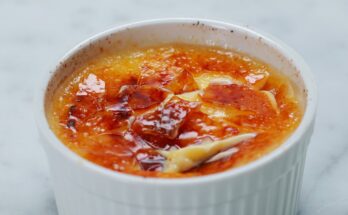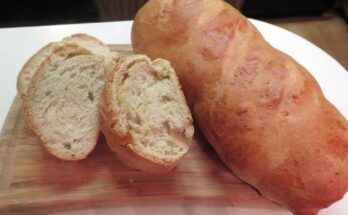Boneless Beef Ribs Recipe: When it comes to hearty, flavorful meals, boneless beef ribs are a classic choice. These meaty cuts are packed with flavor, easy to cook, and versatile enough for different cooking methods, whether you want to grill them outdoors, roast them in the oven, or slow-cook them for melt-in-your-mouth tenderness.
In this detailed guide, we’ll cover everything you need to make restaurant-quality boneless beef ribs right in your own kitchen.
Why Choose Boneless Beef Ribs?
Boneless beef ribs stand out as a favorite for home cooks and professional chefs alike. Unlike bone-in ribs, these are easier to prepare and eat, making them a convenient choice for family dinners, parties, or special gatherings.
Tender and Juicy Flavor Profile
Boneless beef ribs are known for their marbling and fat content, which helps lock in juiciness during cooking. When prepared correctly, they deliver a rich, beefy flavor that rivals prime cuts of steak. The absence of bones also means you get more meat per serving, making them a great option for hearty appetites.
Versatility in Cooking Methods
Whether you enjoy the smoky char of grilled ribs, the deep flavors from slow-cooking, or the crispy caramelization of oven-baked ribs, boneless beef ribs adapt beautifully to different cooking techniques. Their texture and fat distribution allow them to hold marinades and seasonings well, ensuring every bite is flavorful.
Perfect for Family Meals or BBQ Parties
Because they are easy to portion and serve, boneless beef ribs are perfect for gatherings. You can prepare them ahead of time, let them marinate overnight, and simply cook when needed. Plus, they pair wonderfully with classic sides like mashed potatoes, grilled corn, or coleslaw.
Ingredients You’ll Need
The secret to mouthwatering boneless beef ribs lies in the right combination of ingredients. Below is a breakdown of what you’ll need.
Primary Ingredients for Boneless Beef Ribs
- 2–3 pounds of boneless beef ribs (choose well-marbled cuts for extra tenderness)
- 2 tablespoons olive oil (helps sear and lock in flavor)
Marinade and Seasoning Essentials
- 3 cloves garlic, minced
- 1 medium onion, finely chopped
- ½ cup soy sauce
- ¼ cup Worcestershire sauce
- ½ cup brown sugar (balances savory flavors with sweetness)
- 1 teaspoon paprika
- 1 teaspoon black pepper
- 1 teaspoon salt
- 1 teaspoon chili flakes (optional, for a spicy kick)
- 2 tablespoons apple cider vinegar (for tenderizing)
Optional Add-Ons for Extra Flavor
- ¼ cup honey or maple syrup (for sticky, glazed ribs)
- 1 tablespoon mustard (adds tanginess)
- Fresh herbs like rosemary or thyme for aroma
- BBQ sauce for finishing glaze
Kitchen Tools and Equipment
Before you start cooking, make sure you have the right tools. This ensures your boneless beef ribs turn out perfectly.
Cooking Utensils
- Sharp chef’s knife and cutting board
- Mixing bowls for marinade preparation
- Tongs for flipping ribs
Grilling vs. Oven-Baking Tools
- For grilling: Charcoal or gas grill, basting brush, meat thermometer
- For oven-baking: Baking tray, aluminum foil, roasting rack
- For slow-cooking: Crockpot or Instant Pot
Storage Containers for Leftovers
Since boneless beef ribs taste even better the next day, you’ll want airtight containers for storage. They keep the ribs juicy and prevent them from drying out.
Step-by-Step Guide to Cooking Boneless Beef Ribs
Now let’s dive into the heart of this recipe—the actual cooking process. Follow these steps closely, and you’ll end up with flavorful, tender, and irresistible boneless beef ribs.
Step 1: Preparing the Beef Ribs
Start by patting your ribs dry with paper towels. Trimming off excess fat (while keeping some for flavor) is key. Place them in a large bowl and drizzle with olive oil to coat evenly.
Step 2: Making the Marinade
In a separate bowl, mix garlic, onion, soy sauce, Worcestershire sauce, brown sugar, paprika, black pepper, salt, and apple cider vinegar. Whisk until smooth. If you prefer sticky ribs, add honey or BBQ sauce to the mixture.
Step 3: Marinating the Beef Ribs
Pour the marinade over the beef ribs, making sure they’re fully coated. Cover with plastic wrap and refrigerate for at least 2 hours (overnight is best for maximum flavor).
Step 4: Cooking Methods (Grilling, Oven-Baking, or Slow-Cooking)
- Grilling: Preheat grill to medium heat. Grill ribs for 6–8 minutes per side, basting with extra marinade.
- Oven-Baking: Preheat oven to 325°F (163°C). Place ribs on a baking tray, cover with foil, and bake for 2–2.5 hours. Remove foil, brush with BBQ sauce, and broil for 5 minutes.
- Slow-Cooking: Place ribs in a crockpot with marinade. Cook on low for 6–7 hours or high for 3–4 hours until tender.
Step 5: Serving the Boneless Beef Ribs
Once cooked, let the ribs rest for 5–10 minutes before serving. Garnish with fresh herbs and pair with sides like roasted veggies, garlic bread, or mashed potatoes.
Flavor Variations for Boneless Beef Ribs
One of the best things about boneless beef ribs is how versatile they are when it comes to flavor. You can take the same cut of meat and transform it into something completely different just by changing the marinade or cooking style. Let’s explore some popular variations you can try at home.
Asian-Inspired Ribs
If you love sweet and savory combinations, an Asian twist is perfect. Use a marinade of soy sauce, ginger, garlic, sesame oil, and honey. For extra depth, add a splash of rice vinegar or hoisin sauce. Cook them in the oven or grill, then sprinkle with sesame seeds and chopped green onions before serving. The sticky glaze makes every bite irresistible.
Classic BBQ Ribs
For that smoky American BBQ taste, go with a brown sugar and paprika rub before marinating. Add liquid smoke or smoke them on a charcoal grill with wood chips for authentic flavor. Finish with your favorite BBQ sauce, and you’ll have finger-licking good ribs that remind you of backyard cookouts.
Spicy Kick Ribs
Love some heat? Add chili powder, cayenne, and crushed red pepper flakes to your seasoning mix. A squeeze of lime over the top after cooking balances the spiciness beautifully. These ribs pair well with cooling sides like coleslaw or ranch dip.
Mediterranean Style Ribs
For something unique, try marinating ribs with olive oil, lemon juice, garlic, oregano, and rosemary. Roast them in the oven and serve with tzatziki or roasted potatoes. It’s a lighter, herb-packed variation that still delivers bold flavor.
Tips for Perfectly Cooked Boneless Beef Ribs
Cooking ribs may seem simple, but getting that juicy, tender texture with deep flavor requires a few tricks. Here are some expert tips to ensure your ribs turn out perfect every time.
Don’t Skip the Marinade
Marinating isn’t just about flavor—it also tenderizes the meat. Letting your ribs rest in marinade for at least 4 hours (ideally overnight) makes a huge difference.
Low and Slow is the Secret
The best ribs are cooked low and slow. Whether in the oven, grill, or slow cooker, this method breaks down the connective tissue, leaving the meat tender and juicy.
Rest Before Serving
Just like steak, ribs benefit from resting before slicing or serving. A 5–10 minute rest allows juices to redistribute, so your meat stays moist instead of drying out.
Use a Meat Thermometer
To avoid overcooking or undercooking, check the internal temperature. Ribs are done at around 190°F–203°F (88°C–95°C) for fall-apart tenderness.
Best Side Dishes to Serve with Boneless Beef Ribs
Ribs are the star of the show, but the right sides take your meal to another level. Here are some tried-and-true pairings that complement boneless beef ribs beautifully.
Classic Comfort Sides
- Mashed Potatoes: Creamy and buttery, they balance the richness of ribs.
- Cornbread: A slightly sweet, crumbly bread that soaks up sauces perfectly.
- Mac and Cheese: Gooey, cheesy, and indulgent—ideal for BBQ-style meals.
Light and Fresh Options
- Coleslaw: The crunchy freshness cuts through the heaviness of the meat.
- Grilled Vegetables: Bell peppers, zucchini, and mushrooms pair wonderfully.
- Garden Salad: A simple option with vinaigrette keeps things balanced.
Unique Pairings
- Baked Beans: Smoky, sweet, and savory all in one bite.
- Garlic Bread: Adds crunch and extra flavor to your meal.
- Roasted Sweet Potatoes: Their natural sweetness complements spicy or smoky ribs.
Storing and Reheating Boneless Beef Ribs
Made too much? Don’t worry—boneless beef ribs store well and taste just as good reheated, sometimes even better.
How to Store
- Refrigerate cooked ribs in an airtight container for up to 3–4 days.
- For longer storage, freeze them. Wrap in foil, place in a freezer bag, and they’ll last up to 3 months.
How to Reheat
- Oven Method: Preheat to 250°F (120°C). Wrap ribs in foil with a splash of beef broth or BBQ sauce. Heat for 20–30 minutes.
- Stovetop Method: Warm in a skillet over medium heat with a bit of sauce to prevent drying.
- Microwave Method: Quick but less ideal. Use a damp paper towel to cover ribs and reheat in short bursts.
Common Mistakes to Avoid When Cooking Ribs
Even the best cooks make mistakes with ribs. Avoid these pitfalls to get perfect results.
- Skipping the Marinade: Leads to bland and tough meat.
- Cooking Too Fast: High heat dries out the ribs before they get tender.
- Not Covering in the Oven: If you bake ribs uncovered too long, they lose moisture.
- Over-Saucing Early: Applying BBQ sauce too soon can burn because of its sugar content. Add it in the last 10–15 minutes.
- Not Resting Before Serving: Cutting too early makes juices run out, leaving dry ribs.
Health Benefits of Boneless Beef Ribs
While boneless beef ribs are often seen as indulgent comfort food, they actually come with several nutritional benefits when eaten in moderation. Understanding what they bring to the table can help you enjoy them guilt-free.
High in Protein
Boneless beef ribs are packed with protein, which is essential for muscle growth, repair, and overall body function. A single serving can give you a hefty boost of protein, making it great for athletes, gym-goers, or anyone needing an energy-packed meal.
Rich in Vitamins and Minerals
Beef is naturally high in iron, which helps transport oxygen through your blood, and zinc, which supports immune function. You’ll also get B vitamins like B12, which play a role in energy metabolism and brain health.
Healthy Fats in Moderation
While ribs do contain fat, it’s not all bad. Some of the fat provides essential fatty acids that your body needs for energy and hormone production. Choosing well-trimmed cuts and balancing your plate with veggies helps keep your meal nutritious.
The Balance Factor
Pairing ribs with lighter sides like fresh salads, grilled vegetables, or whole grains helps balance out the richness. This way, you can enjoy ribs as part of a healthy, satisfying diet.
Different Cooking Styles for Boneless Beef Ribs
The beauty of boneless beef ribs lies in how many different ways you can cook them. Each method offers a unique texture and flavor profile, so it’s worth trying them all to see which one you love most.
Grilling
Grilling gives ribs that smoky, charred flavor that’s perfect for summer BBQs. Cook them over medium heat, flipping occasionally, and brush with marinade or BBQ sauce for a caramelized finish.
Oven-Baking
If you want fall-apart tenderness, oven-baking is the way to go. Cooking low and slow (around 325°F) for a couple of hours breaks down the connective tissue, leaving ribs soft and juicy. Broiling at the end gives them a nice crust.
Slow-Cooking
The crockpot is your best friend if you want set-and-forget ribs. Add the ribs and marinade, set it to low for 6–7 hours, and come back to meat that literally melts in your mouth.
Instant Pot/Pressure Cooking
For a quicker option, pressure cooking gets the job done in under an hour. It locks in flavor and tenderness, making it a great weeknight choice when you don’t have all day.
How to Make Your Own BBQ Sauce for Ribs
Store-bought BBQ sauces are convenient, but nothing beats homemade. With just a few pantry staples, you can whip up a sauce that’s tailored to your taste.
Basic Homemade BBQ Sauce Recipe
- 1 cup ketchup
- ½ cup apple cider vinegar
- ½ cup brown sugar
- 2 tbsp Worcestershire sauce
- 1 tsp smoked paprika
- 1 tsp garlic powder
- 1 tsp onion powder
- ½ tsp black pepper
Directions
- Combine all ingredients in a saucepan over medium heat.
- Stir and let simmer for 10–15 minutes until thickened.
- Taste and adjust seasoning—add more sugar for sweetness or vinegar for tang.
- Brush onto ribs in the last 15 minutes of cooking for that sticky, caramelized glaze.
This simple sauce adds a homemade touch and elevates your boneless beef ribs to the next level.
Pairing Drinks with Boneless Beef Ribs
A great meal deserves the perfect drink pairing. The richness of boneless beef ribs goes well with both alcoholic and non-alcoholic options.
Best Alcoholic Pairings
- Red Wine: Bold reds like Cabernet Sauvignon or Malbec enhance the deep flavors of beef.
- Beer: A dark stout or hoppy IPA cuts through the richness and balances the flavors.
- Whiskey: A smoky bourbon or whiskey pairs beautifully with BBQ-style ribs.
Non-Alcoholic Pairings
- Iced Tea: A refreshing glass of sweet tea balances the savory richness.
- Lemonade: The tangy citrus cuts through heavy flavors.
- Sparkling Water with Lime: Keeps things light and refreshing.
FAQs about Boneless Beef Ribs Recipe
1. What’s the difference between boneless and bone-in beef ribs?
Bone-in ribs have more connective tissue and require longer cooking times. Boneless ribs are easier to handle and cook quicker, making them ideal for weeknight meals.
2. Can I make boneless beef ribs in advance?
Yes! You can marinate them a day ahead or even fully cook and store them. Just reheat gently to avoid drying them out.
3. How do I know when my ribs are done?
Use a meat thermometer. For tender ribs, aim for an internal temperature of 190°F–203°F. At this point, the meat will be juicy and pull apart easily.
4. What’s the best cut of beef for boneless ribs?
Most boneless beef ribs come from the chuck or plate section. Look for cuts with good marbling, as the fat keeps them juicy during cooking.
5. Can I use the same recipe for pork ribs?
Yes, but adjust cooking times slightly. Pork ribs are leaner, so they may cook faster and need extra sauce or basting to keep moist.
Conclusion
Boneless beef ribs are the perfect blend of hearty flavor, juicy tenderness, and cooking versatility. Whether you’re grilling outdoors, slow-cooking for a cozy dinner, or baking in the oven, they deliver a meal that’s bound to impress. With the right marinade, sides, and drink pairings, you can turn a simple recipe into a restaurant-quality experience at home.
So next time you’re craving comfort food, skip the takeout and whip up some boneless beef ribs yourself. You’ll not only save money but also enjoy the satisfaction of creating a dish that brings family and friends together around the table.



